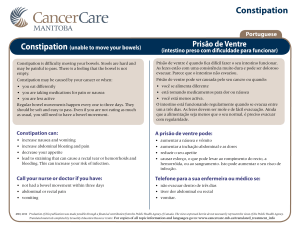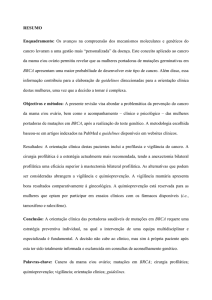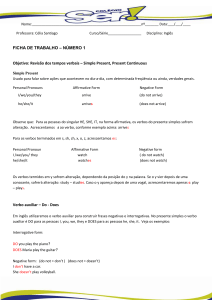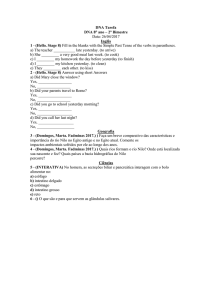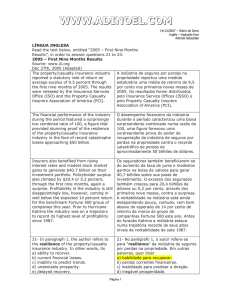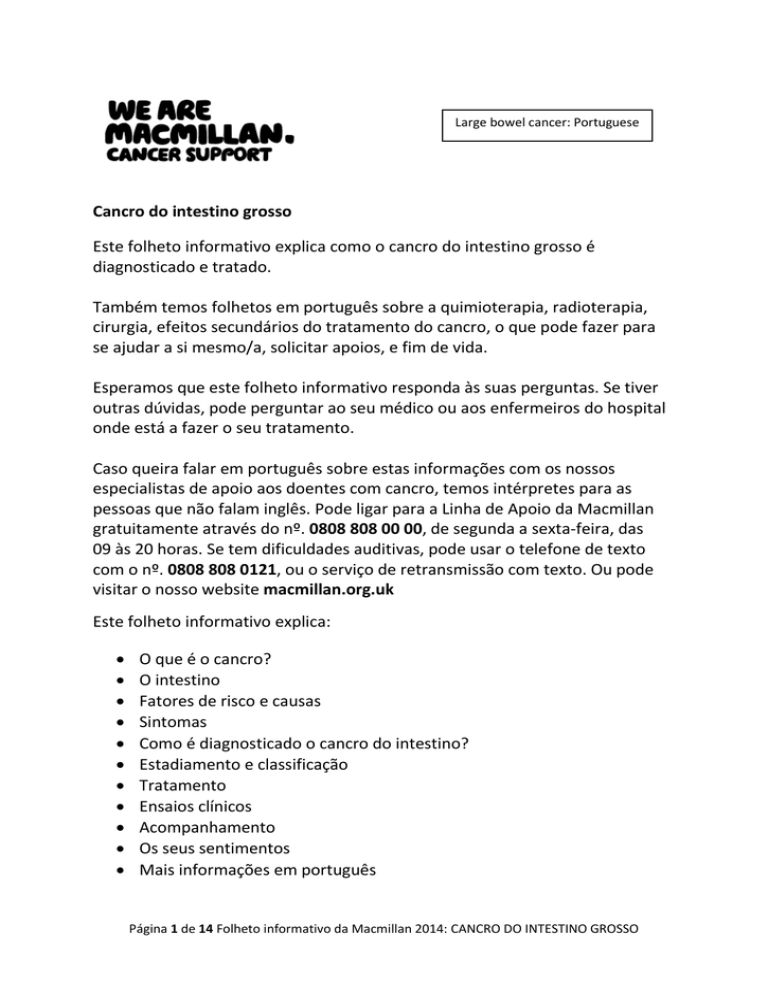
Large bowel cancer: Portuguese
Cancro do intestino grosso
Este folheto informativo explica como o cancro do intestino grosso é
diagnosticado e tratado.
Também temos folhetos em português sobre a quimioterapia, radioterapia,
cirurgia, efeitos secundários do tratamento do cancro, o que pode fazer para
se ajudar a si mesmo/a, solicitar apoios, e fim de vida.
Esperamos que este folheto informativo responda às suas perguntas. Se tiver
outras dúvidas, pode perguntar ao seu médico ou aos enfermeiros do hospital
onde está a fazer o seu tratamento.
Caso queira falar em português sobre estas informações com os nossos
especialistas de apoio aos doentes com cancro, temos intérpretes para as
pessoas que não falam inglês. Pode ligar para a Linha de Apoio da Macmillan
gratuitamente através do nº. 0808 808 00 00, de segunda a sexta-feira, das
09 às 20 horas. Se tem dificuldades auditivas, pode usar o telefone de texto
com o nº. 0808 808 0121, ou o serviço de retransmissão com texto. Ou pode
visitar o nosso website macmillan.org.uk
Este folheto informativo explica:
O que é o cancro?
O intestino
Fatores de risco e causas
Sintomas
Como é diagnosticado o cancro do intestino?
Estadiamento e classificação
Tratamento
Ensaios clínicos
Acompanhamento
Os seus sentimentos
Mais informações em português
Página 1 de 14 Folheto informativo da Macmillan 2014: CANCRO DO INTESTINO GROSSO
O que é o cancro?
Os órgãos e tecidos do corpo são constituídos por minúsculos elementos base
chamados células. O cancro é uma doença dessas células.
As células de cada parte do organismo são diferentes, mas na sua maioria
reparam-se e reproduzem-se a si mesmas da mesma forma. Normalmente, as
células dividem-se de forma ordenada. Mas se o processo se descontrolar, as
células continuam a dividir-se e transformam-se numa massa a que se chama
tumor.
Nem todos os tumores são cancerígenos. Os médicos podem saber se um
tumor é cancerígeno removendo uma pequena amostra de tecido ou células
do tumor. Chama-se a isso uma biópsia. Os médicos examinam a amostra ao
microscópio para procurarem células cancerígenas.
Num tumor benigno (não-cancerígeno), as células podem crescer, mas não se
podem espalhar para nenhuma outra parte do corpo. Geralmente, só causa
problemas se fizer pressão sobre os órgãos próximos.
Num tumor maligno (cancerígeno), as células crescem para os tecidos mais
próximos. Por vezes, as células cancerígenas espalham-se a partir de onde o
cancro começou (o local primário) para outras partes do corpo. Podem viajar
através do sangue ou do sistema linfático.
O sistema linfático ajuda a proteger-nos de infeções e doenças. É composto
por tubos finos chamados vasos linfáticos. Estes ligam-se a grupos de nódulos
linfáticos em forma de feijão (glândulas) por todo o corpo.
Quando as células atingem outra parte do corpo, começam a crescer e formam
outro tumor. Chama-se a isso um cancro secundário ou metástase.
O intestino
O intestino faz parte do nosso sistema digestivo. Tem duas partes: o intestino
delgado e o intestino grosso. O intestino grosso é constituído pelo cólon, o reto
e o ânus.
Página 2 de 14 Folheto informativo da Macmillan 2014: CANCRO DO INTESTINO GROSSO
O intestino - cólon e reto
Esófago
Estômag
o
Cólon
ascendente
Intestino
delgado
Reto
Cólon
transverso
Cólon
descendente
Cólon
sigmoide
Ânus
Quando engole os alimentos, eles descem através do esófago até ao
estômago, onde começa a digestão. Passam depois através do intestino
delgado, onde os nutrientes essenciais são levados para dentro do corpo.
Os alimentos digeridos movem-se depois para o cólon, onde a água é
absorvida. Os dejetos restantes, conhecidos como fezes, são retidos no reto
(passagem anal) até que estejam prontos para saírem do corpo através do
ânus na forma de um movimento intestinal (fezes).
As paredes do cólon e do reto são compostas de camadas de tecido corporal. A
maioria dos cancros do cólon e do reto começam no revestimento interno do
intestino e desenvolvem-se a partir de pequenos tumores chamados pólipos.
O cancro do intestino grosso chama-se cancro do cólon e do reto. Também é
chamado cancro colo-retal.
Causas e fatores de risco
Não sabemos o que é que causa o cancro do intestino na maioria das pessoas.
Há alguns fatores de risco que podem aumentar as suas hipóteses de ter
cancro.
Idade – O risco de desenvolver cancro do intestino aumenta com a idade.
Página 3 de 14 Folheto informativo da Macmillan 2014: CANCRO DO INTESTINO GROSSO
Dieta – Uma dieta que contenha uma grande quantidade de carnes
vermelhas e processadas e poucas frutas e vegetais frescos pode aumentar
esse risco. Comer carne frita ou grelhada também pode aumentar o risco.
Estilo de vida – Fazer pouco exercício e ter excesso de peso. Inclui também
fumar muito e beber mais do que as quantidades recomendadas de bebidas
alcoólicas ao longo de muitos anos.
Historial familiar – As pessoas que têm na família casos de cancro do
intestino podem ter um risco maior. Pensa-se que apenas cerca de 5% (5
em cada 100) dos cancros do intestino grosso são causados por um gene
defeituoso herdado. Fale com o seu médico se estiver preocupado com o
seu historial familiar.
Doenças familiares – Duas doenças raras que podem ocorrer nas famílias,
chamadas de polipose adenomatosa familiar (FAP) e cancro colo-retal
hereditário sem polipose (HNPCC), podem aumentar o risco de desenvolver
cancro do intestino.
Antecedentes de doença inflamatória intestinal – As pessoas que já tiveram
colite ulcerativa ou doença de Crohn (doenças da mucosa do intestino)
durante muito tempo, têm um maior risco de desenvolver cancro do
intestino.
O cancro do intestino não é contagioso e não se transmite a outras pessoas.
Sintomas
Os sintomas do cancro do intestino incluem:
sangue nas fezes – o sangue pode ser vermelho vivo ou escuro
uma mudança nos seus hábitos intestinais normais (como diarreia ou
prisão de ventre) sem razão aparente e que dure mais de seis semanas
perda de peso inexplicável
dores na barriga (abdómen) ou na passagem anal
a sensação de não ter esvaziado o seu intestino completamente depois
de um movimento intestinal
sentir-se cansado e sem fôlego – pode acontecer se o cancro estiver a
sangrar, causando anemia (um número baixo de glóbulos vermelhos).
Por vezes, o cancro pode causar um bloqueio (obstrução) no intestino. Os
sintomas são:
Página 4 de 14 Folheto informativo da Macmillan 2014: CANCRO DO INTESTINO GROSSO
sentir-se enjoado (vómitos)
prisão de ventre
dores no abdomen
sensação de inchaço.
Estes sintomas também podem ser causados por outros problemas, mas é
importante ser examinado pelo seu GP (médico de família).
Como é diagnosticado o cancro do intestino?
Geralmente, começa por ir à consulta do seu GP (médico de família). Vão
apalpar-lhe a barriga (abdómen) e examinar a sua passagem anal. Chama-se a
isso um exame retal.
Durante um exame retal, o médico coloca uma luva e introduz um dedo na sua
passagem anal para procurar caroços ou inchaços. Pode ser um pouco
desconfortável, mas não é doloroso
Pode ter de fazer uma análise ao sangue para ver se tem anemia. Também
pode ter de fazer análises ao sangue para verificar o estado do fígado e dos
rins.
Se o seu GP (médico de família) não tiver a certeza de qual é o problema, ou se
pensar que os seus sintomas podem ser causados por cancro, será
encaminhado para um especialista no hospital. Se o seu GP (médico de família)
pensar que pode ter cancro, deverá ter uma consulta no hospital no prazo de
14 dias.
No hospital
Estes exames podem ser usados para ajudar a diagnosticar o cancro do
intestino. Pode não precisar de os fazer todos.
Proctoscopia/sigmoidoscopia
Um médico ou enfermeiro especialista vai olhar para dentro do revestimento
do intestino grosso e recolher amostras de células (biópsias). Vão passar um
tubo fino suavemente pela sua passagem anal. O tubo tem uma luz e uma
pequena câmara na extremidade. O proctoscópio é um pequeno tubo que
entra apenas no reto. Um sigmoidoscópio é um tubo mais comprido que pode
chegar ao intestino grosso.
Estes exames podem ser desconfortáveis, mas não costumam doer.
Página 5 de 14 Folheto informativo da Macmillan 2014: CANCRO DO INTESTINO GROSSO
Colonoscopia
Para ver o interior de toda a extensão do intestino grosso, o seu médico vai
fazer uma colonoscopia. Durante o exame, vão tirar fotografias e fazer biópsias
das células.
O intestino tem que estar completamente vazio para este exame. Significa que
tem de fazer uma alimentação cuidadosa no dia anterior ao exame e tomar um
medicamento (laxante) para limpar o intestino. No hospital vão dizer-lhe o que
deve fazer. Uma colonoscopia pode ser desconfortável, mas vão dar-lhe um
sedativo para relaxar.
Colonoscopia virtual (colonografia por TAC)
Um aparelho de TAC tira uma série de imagens de raios-x do seu intestino.
Depois, um computador junta as fotos para criar uma imagem tridimensional
do seu intestino.
O intestino tem que estar completamente vazio para o exame. Podem dar-lhe
uma injeção de um medicamento que vai ajudar os músculos do intestino a
relaxarem. Ao mesmo tempo, também podem dar-lhe uma injeção com um
corante (meio de contraste). O seu médico informa-o se tiver de fazer este
exame.
Outros exames
Se a biópsia mostrar que tem cancro, pode ter de fazer outros exames. Esses
exames são para saber o tamanho e a localização do cancro, e para avaliar se já
se espalhou. Estes podem incluir:
análises ao sangue
uma radiografia torácica
uma TAC (CT scan)
um CT/PET
uma MRI (ressonância magnética)
um clister opaco
uma ecografia.
O seu médico ou enfermeiro vão explicar-lhe quais são os exames de que
precisa e o que vai acontecer.
Página 6 de 14 Folheto informativo da Macmillan 2014: CANCRO DO INTESTINO GROSSO
Pode sentir alguma ansiedade enquanto espera pelos resultados. Fale com um
familiar ou um amigo acerca das suas preocupações. Também pode falar com
um dos nossos especialistas de apoio ao cancro em português através do
telefone 0808 808 00 00.
Estadiamento e classificação
Conhecer o estádio e o grau do cancro ajuda os médicos a decidirem o
tratamento certo para si.
Estadiamento
O cancro do pulmão divide-se em quatro estádios:
Estádio 1 – O cancro não se espalhou para além do tumor original.
Estádio 2 – Os tumores podem ter crescido através da parede do intestino e
para os tecidos próximos, mas não se disseminaram para os gânglios
linfáticos próximos.
Estádio 3 – Podem encontrar-se células tumorais nos nódulos linfáticos
próximos.
Estádio 4 – O tumor espalhou-se para outras partes do corpo.
Classificação
A classificação mostra o aspeto das células cancerígenas ao microscópio em
comparação com as células intestinais normais.
Grau 1 (baixo grau) – As células cancerígenas têm um aspeto semelhante às
células normais e um crescimento muito lento.
Grau 2 (grau intermédio) – As células cancerígenas têm um aspeto menos
normal e um crescimento ligeiramente mais rápido.
Grau 3 (alto grau) – As células cancerígenas são muito diferentes das
células normais e tendem a crescer rapidamente.
Tratamento
Nem sempre é fácil decidir qual é o melhor tratamento. O seu médico vai ter
de pensar sobre muitas coisas. As mais importantes são:
o estádio e o grau do cancro
a sua saúde em geral
os efeitos secundários prováveis do tratamento
Página 7 de 14 Folheto informativo da Macmillan 2014: CANCRO DO INTESTINO GROSSO
a sua opinião sobre os possíveis efeitos secundários.
Embora os médicos possam ter uma ideia de quais os tratamentos de que vai
precisar, talvez tenha de ser operado antes de poderem tomar uma decisão.
É importante falar sobre qualquer tipo de tratamento com o seu médico, para
entender o que isso significa. Recomendamos que leve consigo alguém que
fale tanto inglês como português. Podem ser disponibilizados intérpretes se for
necessário, mas deve informar o hospital com antecedência de que gostava de
ter um intérprete presente. Vai ter de assinar um termo de consentimento
para comprovar que entende e concorda com o tratamento. Não lhe podem
fazer nenhum tratamento sem a sua autorização.
O cancro do cólon e o cancro retal são tratados de formas diferentes.
Cirurgia
O tipo de cirurgia que vai fazer depende da fase do cancro e do local do
intestino onde se encontra. O seu médico vai falar consigo acerca disto.
Cirurgia para o cancro do cólon
Colectomia total – remove completamente o cólon.
Hemicolectomia – remove metade do cólon. Pode ser do lado esquerdo ou do
direito, dependendo da localização do cancro.
Colectomia sigmóide – remove o cólon sigmóide.
Durante a cirurgia, a parte do intestino que contém o cancro é removida e as
duas extremidades abertas são depois unidas. Se o intestino não puder ser
unido, pode ser necessário fazer um estoma. O estoma é uma abertura do
intestino na parede do estômago. Pode ser temporário ou permanente. O
médico e enfermeiro especialista vão falar consigo sobre isso antes qualquer
cirurgia. Na secção abaixo pode ver mais informações sobre os estomas.
Os nódulos linfáticos perto do cólon também são removidos, porque o cancro
podia espalhar-se primeiro para eles.
Cirurgia para o cancro retal
Excisão mesorretal total (TME) – remove completamente o reto assim como o
tecido adiposo que o rodeia. Esse tecido contém os gânglios linfáticos.
Página 8 de 14 Folheto informativo da Macmillan 2014: CANCRO DO INTESTINO GROSSO
A operação TME pode ser feita de modos diferentes. Depende do local onde
está o cancro no reto.
Ressecção anterior baixa – é usada para cancros nas partes média e alta do
reto (perto do cólon). A parte do intestino que contém o cancro é removida
e as duas extremidades são unidas. Se o intestino não puder ser unido vai
precisar de um estoma (consulte a secção abaixo sobre estomas).
Ressecção abdominoperineal – costuma ser usada para cancros na
extremidade inferior do reto. Depois desta operação vai precisar de um
estoma permanente.
Cirurgia para o cancro do intestino em estádio inicial
Por vezes, uma operação chamada ressecção local ou ressecção transanal
pode remover pequenos cancros do intestino numa fase muito inicial. Os
instrumentos cirúrgicos são passados através do ânus para o reto ou o cólon
para remover o cancro.
Pode ter de fazer uma segunda operação para remover mais intestino, se o
tumor for de alto grau. Há diferentes formas de remover o cancro dependendo
da sua localização no intestino. O seu médico vai explicar-lhe a operação.
Cirurgia para o cancro do intestino avançado
Se o cancro for demasiado grande para ser removido, pode pressionar o
intestino e torná-lo mais estreito. Por vezes, os médicos podem inserir um
tubo fino de metal (um stent) no intestino para o manter aberto. O stent vai
ser inserido usando um colonoscópio. Vão dar-lhe um sedativo leve para
ajudar a relaxar e depois pode ter de ficar no hospital durante um curto
período de tempo.
Por vezes, pode ter de fazer uma cirurgia para remover o cancro, quando este
se espalhou para apenas uma área do corpo, como o fígado ou os pulmões.
Cirurgia laparoscópica (cirurgia guiada)
Esta operação usa quatro ou cinco pequenos cortes no abdómen, em vez de
uma incisão maior. Um laparoscópio (um tubo fino contendo uma luz e uma
câmara) é passado para dentro do abdómen através de um dos cortes e o
cancro é removido. Geralmente, a recuperação desta operação é mais rápida.
Este tipo de cirurgia é usado em alguns hospitais. O seu cirurgião vai falar
consigo se esta operação for indicada para si.
Página 9 de 14 Folheto informativo da Macmillan 2014: CANCRO DO INTESTINO GROSSO
Estomas
Se as extremidades do intestino não puderem ser unidas, a extremidade
superior pode ser trazida para fora pela pele da parede abdominal. Chama-se a
isso um estoma. Existem dois tipos de estoma: uma ileostomia, que
normalmente é temporária; ou uma colostomia, que muitas vezes é
permanente. Vai usar um saco sobre o estoma para recolher as fezes
(movimentos intestinais).
Um estoma temporário permite que os intestinos recentemente unidos
cicatrizem. Passados alguns meses, vão fazer-lhe outra operação para voltar a
unir o intestino. Chama-se a isso uma reversão do estoma. Os estomas
permanentes (geralmente colostomias) são criados quando não foi possível
voltar a ligar o intestino.
Um enfermeiro de estoma vai dar-lhe mais conselhos e informações.
Quimioterapia
A quimioterapia é um tratamento que usa medicamentos anti-cancerígenos
(citotóxicos) para destruir as células cancerígenas. Normalmente, não é
necessária para cancros do intestino no estádio 1.
Para cancros do intestino no estádio 2, o risco de o cancro voltar é baixo, por
isso pode não precisar de quimioterapia. Fazer quimioterapia após a cirurgia é
conhecido por tratamento adjuvante. É para reduzir o risco de o cancro voltar.
Geralmente, é aconselhada a quimioterapia às pessoas com cancro do
intestino no estádio 3.
Por vezes, a quimioterapia é dada antes de uma operação. Chama-se a isso
quimioterapia neoadjuvante. É para tornar o cancro mais pequeno, para ser
mais fácil de remover. Após este tratamento, talvez possa evitar ter um
estoma permanente.
Quimiorradioterapia
É uma combinação de quimioterapia e radioterapia. Costuma chamar-se
quimiorradiação.
Os medicamentos de quimioterapia podem tornar as células cancerígenas mais
sensíveis à radioterapia. A combinação dos tratamentos pode ser mais eficaz
do que fazer quimioterapia ou radioterapia isoladamente.
Página 10 de 14 Folheto informativo da Macmillan 2014: CANCRO DO INTESTINO GROSSO
Administrar a quimioterapia e a radioterapia juntas pode agravar os efeitos
secundários dos tratamentos. O seu médico ou enfermeiro especialista podem
dar-lhe mais informações sobre a quimiorradioterapia e os possíveis efeitos
secundários deste tratamento.
Cancros do intestino avançados
A quimioterapia também pode ser dada quando o cancro já se espalhou para
outra parte do corpo (cancro secundário ou avançado). O objetivo é diminuir o
cancro e reduzir os sintomas. Por vezes, pode ajudá-lo a viver mais tempo.
Temos mais informação em português sobre como a quimioterapia é
administrada e alguns dos efeitos secundários que pode sentir.
Terapias direcionadas (biológicas)
As terapias direcionadas atuam na diferença entre as células cancerígenas e as
células normais e tentam impedir que as células cancerígenas cresçam.
Existem vários tipos diferentes. Os principais utilizados para tratar o cancro do
intestino são o cetuximab (Erbitux®), o bevacizumab (Avastin®), o panitumab
(Vectibix®) e o aflibercept (Zaltrap®).
Podem ser usados para tratar cancros colo-retais que se espalharam para fora
do intestino. Nem todos os cancros do intestino respondem ao cetuximab ou
ao panitumumab.
Radioterapia
A radioterapia trata o cancro usando radiação de alta energia para destruir as
células cancerígenas, mas causando o mínimo dano possível às células
normais.
Pode ser usada para aliviar os sintomas do cancro do cólon, embora isso seja
raro.
Radioterapia para o cancro retal
Antes da cirurgia
Pode fazer radioterapia antes da cirurgia para tornar o cancro retal mais
pequeno e mais fácil de remover. Também reduz a probabilidade de o cancro
voltar.
Página 11 de 14 Folheto informativo da Macmillan 2014: CANCRO DO INTESTINO GROSSO
Pode ter de fazer um ciclo curto de radioterapia durante uma semana antes da
cirurgia. Ou pode ter de fazer um ciclo mais prolongado, que pode durar até
seis semanas. O tratamento mais longo é geralmente administrado com a
quimioterapia (quimiorradioterapia), que pode ajudar a fazer com que a
radioterapia seja mais eficaz.
Após o ciclo de radioterapia, tem de esperar algumas semanas para que os
efeitos secundários acalmem antes de poder fazer a operação.
Depois da cirurgia
Se não fizer radioterapia antes da cirurgia, pode ter de fazê-la depois. Isso
pode acontecer se:
o cancro foi difícil de remover
algumas células cancerígenas tiverem ficado para trás
o cancro se tiver espalhado através da parede do intestino ou para os
nódulos linfáticos próximos.
Podem dar-lhe este tipo de radioterapia todos os dias da semana durante 4–5
semanas.
Cancro retal avançado
Se o cancro se espalhar ou se voltar (especialmente na região pélvica), depois
do primeiro tratamento, pode fazer radioterapia para o reduzir. Isso também
pode aliviar os sintomas, como as dores.
Temos mais informações em português sobre como a quimioterapia é
planeada e administrada e alguns dos efeitos secundários que pode sentir.
Ensaios clínicos
Realizam-se estudos sobre o cancro para tentar encontrar novos e melhores
tratamentos para o cancro. Os estudos que são realizados em pacientes
chamam-se ensaios clínicos. Atualmente, muitos hospitais participam nesses
ensaios. Fale com o seu médico sobre a situação da investigação do cancro do
intestino grosso.
Acompanhamento
Depois de terminar o tratamento, vai ter de fazer exames médicos e análises
ao sangue com regularidade. Também pode ter de fazer uma TAC e
Página 12 de 14 Folheto informativo da Macmillan 2014: CANCRO DO INTESTINO GROSSO
colonoscopias. Poderá ter de fazer estes exames durante vários anos, mas vão
tornar-se cada vez menos frequentes.
Os seus sentimentos
Poderá sentir-se oprimido quando lhe disserem que tem cancro, e sentir
muitas emoções diferentes. Estas podem incluir raiva, ressentimento, culpa,
ansiedade e medo. Estas reações são normais e fazem parte do processo por
que muitas pessoas passam na tentativa de conseguirem lidar com a doença.
Não existe uma forma certa ou errada de se sentir. Vai enfrentar as coisas à
sua própria maneira.
Mais informações em português
Folheto informativo sobre o cancro da mama
Folheto informativo sobre a quimioterapia
Folheto informativo sobre como requerer subsídios
Folheto informativo sobre o cancro do pulmão
Folheto informativo sobre o cancro da próstata
Folheto informativo sobre a radioterapia
Folheto informativo sobre os efeitos secundários do tratamento contra o
cancro
Folheto informativo sobre a cirurgia
Folheto informativo sobre o que pode fazer para se ajudar a si mesmo
Este folheto informativo foi escrito, revisto e editado pela equipa de
Desenvolvimento de Informação de Apoio ao Cancro da Macmillan. Foi
aprovado pelo nosso editor médico, Dr. Tim Iveson, Consultor de Oncologia
Clínica.
Com agradecimentos a Aileen Roy, Enfermeira Clínica Especialista Colorretal;
Fiona Butler, Enfermeira Clínica Especialista em Cancro Colorretal; e às pessoas
afetadas pelo cancro que reviram esta folha informativa.
Este folheto informativo foi criado usando informações de diversas fontes de
confiança, incluindo:
Improving Outcomes in Colorectal Cancer: The Manual Update. (Melhorar
os resultados do cancro colorretal: atualização do manual) Junho de 2004.
National Institute for Health and Care Excellence - NICE (Instituto Nacional
para a Excelência na Saúde e Prestação de Cuidados).
Página 13 de 14 Folheto informativo da Macmillan 2014: CANCRO DO INTESTINO GROSSO
Management of Colorectal Cancer: A National Clinical Guideline. (Gestão do
cancro colorretal: uma orientação clínica nacional) Março de 2003. Scottish
Intercollegiate Guidelines Network (SIGN). (Rede Interuniversitária de
orientações escocesa)
Computerised tomographic colonoscopy (virtual colonoscopy) – guidance .
(Colonoscopia tomográfica Informatizada (colonoscopia virtual) orientação) Junho de 2005. NICE.
Cetuximab for the First-line Treatment of Metastatic Colorectal Cancer . (O
cetuximab para o tratamento de primeira linha do cancro colorretal
metastático) Agosto de 2009. NICE.
Nós fazemos todos os esforços para garantir que a informação que fornecemos
é exata, mas esta não deve ser considerada como refletindo o estado atual da
investigação médica, que está em constante mudança. Se está preocupado
com a sua saúde, deve consultar o seu médico. A Macmillan não é responsável
por quaisquer perdas ou danos resultantes de qualquer inexatidão nesta
informação, ou nas informações de terceiros, tais como as informações nos
sítios da Internet aos quais estamos ligados.
© Macmillan Cancer Support 2014. (Apoio ao Cancro da © Macmillan 2014 )
Instituição de solidariedade social registada em Inglaterra e no País de Gales
(261017), Escócia (SC039907) e na Ilha de Man (604). Sede social 89 Albert
Embankment, London SE1 7UQ.
MAC15136_Portuguese
Página 14 de 14 Folheto informativo da Macmillan 2014: CANCRO DO INTESTINO GROSSO
Large bowel cancer: English
Large bowel cancer
This fact sheet is about how cancer of the large bowel is diagnosed and treated.
We also have fact sheets in your language about chemotherapy, radiotherapy, surgery,
side effects of cancer treatment, what you can do to help yourself, claiming benefits and
end of life.
We hope this fact sheet answers your questions. If you have any more questions, you
can ask your doctor or nurse at the hospital where you are having treatment.
If you would like to talk to our cancer support specialists about this information in your
language, we have interpreters for non-English speakers. You can call the Macmillan
Support Line free on 0808 808 00 00, Monday–Friday, 9am–8pm. If you have
problems hearing you can use textphone 0808 808 0121, or Text Relay. Or you can go
to our website macmillan.org.uk
This fact sheet is about:
•
•
•
•
•
•
•
•
•
•
•
What is cancer?
The bowel
Risk factors and causes
Symptoms
How is bowel cancer diagnosed?
Staging and grading
Treatment
Clinical trials
Follow up
Your feelings
More information in your language
Page 1 of 11 Macmillan fact sheet 2014: Large bowel cancer
What is cancer?
The organs and tissues of the body are made up of tiny building blocks called cells.
Cancer is a disease of these cells.
Cells in each part of the body are different but most mend and reproduce themselves
in the same way. Normally, cells divide in an orderly way. But if the process gets out of
control, the cells carry on dividing and develop into a lump called a tumour.
Not all tumours are cancer. Doctors can tell if a tumour is cancer by removing a small
sample of tissue or cells from it. This is called a biopsy. The doctors examine the sample
under a microscope to look for cancer cells.
In a benign (non-cancerous) tumour, the cells may grow but cannot spread anywhere
else in the body. It usually only causes problems if it puts pressure on nearby organs.
In a malignant (cancerous) tumour, the cells grow into nearby tissue. Sometimes, cancer
cells spread from where the cancer first started (the primary site) to other parts of the
body. They can travel through the blood or lymphatic system.
The lymphatic system helps to protect us from infection and disease. It’s made up of fine
tubes called lymphatic vessels. These connect to groups of bean-shaped lymph nodes
(glands) all over the body.
When the cells reach another part of the body they begin to grow and form another
tumour. This is called secondary cancer or a metastasis.
The bowel
The bowel is part of our digestive system. It has two parts: the small bowel and the large
bowel. The large bowel is made up of the colon, rectum and anus.
Gullet
(oesophagus)
Stomachx
Ascending
colonx
Small bowelx
Rectumx
xTransverse
colon
xDescending
colon
xSigmoid
colon
xAnus
The digestive system
Page 2 of 11 Macmillan fact sheet 2014: Large bowel cancer
When you swallow food it passes down the gullet (oesophagus) to the stomach, where
digestion begins. It then passes through the small bowel, where essential nutrients are
taken into the body.
The digested food then moves into the colon, where water is absorbed. The remaining
waste matter, known as stools or faeces, is held in the rectum (back passage) until it’s
ready to be passed from the body through the anus as a bowel motion (stool).
The walls of the colon and rectum are made up of layers of body tissue. Most colon
and rectal cancers start in the inner lining of the bowel and develop from small growths
called polyps.
Cancer of the large bowel is cancer of the colon and rectum. It’s also called colorectal
cancer.
Causes and risk factors
We don’t know what causes bowel cancer in most people. There are some risk factors
that can increase your chances of getting it.
• Age – The risk of developing bowel cancer increases with age.
• Diet – A diet containing a lot of red and processed meats and low in fruit and fresh
vegetables can increase your risk. Eating fried or grilled meat might also increase
your risk.
• Lifestyle – This includes getting little exercise and being overweight. It also includes
smoking heavily and drinking more than the recommended amounts of alcohol over
many years.
• Family history – People who have one or more family members with bowel cancer
may have a higher risk of developing it. Only about 5% of (5 in every 100) large
bowel cancers are thought to be caused by an inherited faulty gene. Talk to your
doctor if you are worried about your family history.
• Familial conditions – Two rare conditions that can run in families, called familial
adenomatous polyposis (FAP) and hereditary non-polyposis colon cancer (HNPCC),
can increase the risk of developing bowel cancer.
• Personal history of inflammatory bowel disease – People who’ve had ulcerative
colitis or Crohn’s disease (diseases of the lining of the bowel) for a long time have an
increased risk of developing bowel cancer.
Bowel cancer is not infectious and cannot be passed on to other people.
Page 3 of 11 Macmillan fact sheet 2014: Large bowel cancer
Symptoms
Symptoms of bowel cancer include:
• blood in, or on, the bowel motions – the blood may be bright red or dark in colour
• a change in your normal bowel habit (such as diarrhoea or constipation) for no
obvious reason, lasting for longer than six weeks
•
•
•
•
unexplained weight loss
pain in the tummy (abdomen) or back passage
a feeling of not having emptied your bowel properly after a bowel motion
feeling tired and breathless – this can happen if the cancer is bleeding causing
anaemia (a low number of red blood cells).
Sometimes the cancer can cause a blockage (obstruction) in the bowel. The symptoms of
this are:
•
•
•
•
being sick (vomiting)
constipation
pain in the abdomen
a bloated feeling.
These symptoms can be caused by other conditions too, but it is important that you
always have them checked by your GP.
How is bowel cancer diagnosed?
You usually begin by seeing your GP. They will feel your tummy (abdomen) and examine
your back passage. This is called a rectal examination.
During a rectal examination, the doctor places a gloved finger into your back passage to
feel for any lumps or swellings. This may be slightly uncomfortable, but it’s not painful
You may have a blood test to check for anaemia. You may also have blood tests to
check the health of your liver and kidneys.
If your GP is not sure what the problem is, or thinks that your symptoms could be caused
by cancer, they will refer you to a hospital specialist. If your GP thinks you may have
cancer, you should be seen at the hospital within 14 days.
Page 4 of 11 Macmillan fact sheet 2014: Large bowel cancer
At the hospital
These tests can be used to help diagnose bowel cancer. You may not need all of them.
Proctoscopy/sigmoidoscopy
A doctor or specialist nurse will look inside the lining of the large bowel and take
samples of cells (biopsies). They will gently pass a thin tube into your back passage. The
tube has a light and tiny camera on the end. A proctoscope is a short tube that goes just
into the rectum. A sigmoidoscope is a longer tube that can be passed further up into the
large bowel.
A proctoscopy or a sigmoidoscopy can be uncomfortable but it doesn’t usually hurt.
Colonoscopy
To look inside the whole length of the large bowel, your doctor will do a colonoscopy.
During the test, they will take photographs and biopsies of the cells.
The bowel has to be completely empty for this test. This means following a careful diet
for the day before your test and taking a medicine (laxative) to clear the bowel. Your
hospital will tell you what to do. A colonoscopy can be uncomfortable, but you will be
given a sedative that will help to relax you.
Virtual colonoscopy (CT colonography)
A CT scanner takes a series of x-ray pictures of your bowel. A computer then puts the
pictures together to give a three-dimensional picture of your bowel.
Your bowel has to be completely empty for the scan. You may be given an injection
of a medicine that will help the muscles of your bowel to relax. You may also have an
injection of a dye (contrast medium) at the same time. Your doctor will tell you if you are
going to have this.
Further tests
If the biopsy shows that you have cancer, you may have other tests too. These aim to
find out the size and position of the cancer, and to see whether it has spread. They may
include:
•
•
•
•
•
•
•
blood tests
a chest x-ray
a CT scan
a CT/PET scan
an MRI scan
a barium enema
an ultrasound scan.
Your doctor or nurse will explain which tests you need and what will happen.
Waiting for test results can be an anxious time for you. It may help to talk about your
worries with a relative or friend. You could also speak to one of our cancer support
specialists in your language on 0808 808 00 00.
Page 5 of 11 Macmillan fact sheet 2014: Large bowel cancer
Staging and grading
Knowing the stage and grade of the cancer helps doctors decide on the right treatment
for you.
Staging
Bowel cancer is divided into four stages:
• Stage 1 – The cancer has not spread beyond the original tumour.
• Stage 2 – Tumours may have grown through the bowel wall and into nearby tissues,
but have not spread to nearby lymph nodes.
• Stage 3 – Tumour cells can be found in nearby lymph nodes.
• Stage 4 – The tumour has spread to other parts of the body.
Grading
Grading shows how the cancer cells look under the microscope compared with normal
bowel cells.
• Grade 1 (low-grade) – The cancer cells look similar to normal cells and grow very
slowly.
• Grade 2 (moderate-grade) – The cancer cells look more abnormal and are slightly
faster growing.
• Grade 3 (high-grade) – The cancer cells look very different from normal cells and
tend to grow quickly.
Treatment
Deciding on the best treatment isn’t always easy. Your doctor will need to think about a
lot of things. The most important of these are:
•
•
•
•
the stage and grade of the cancer
your general health
the likely side effects of treatment
your views about the possible side effects.
Although your doctors may have a good idea about which treatments you will need, you
may need to have an operation before they can decide.
It’s important to talk about any treatment with your doctor, so that you understand what
it means. It’s a good idea to take someone with you who can speak both your language
and English. Interpreters may be available if you need one, but try to let the hospital
know before if you would like one to be there. You will have to sign a consent form to
show that you understand and agree to the treatment. You will not be given a treatment
unless you have agreed to it.
Page 6 of 11 Macmillan fact sheet 2014: Large bowel cancer
Colon cancer and rectal cancer are treated in different ways.
Surgery
The type of surgery you have depends on the stage of the cancer and where it is in the
bowel. Your doctor will talk to you about this.
Surgery for colon cancer
Total colectomy – removes the whole colon.
Hemi-colectomy – removes half of the colon. This may be the left or right side,
depending on where the cancer is.
Sigmoid colectomy – removes the sigmoid colon.
During the surgery, the piece of bowel that contains the cancer is removed and the two
open ends are then joined together. If the bowel can’t be joined together, you may need
a stoma. This is an opening of the bowel on the tummy wall. It may be temporary or
permanent. Your doctor and specialist nurse will talk to you about this before you have
any surgery. There is more information about stomas in the section below.
The lymph nodes near the colon are also removed. This is because the cancer would
spread to them first.
Surgery for rectal cancer
Total mesorectal excision (TME) – removes the whole rectum as well as the fatty
tissue that surrounds it. This tissue contains the lymph nodes.
The TME operation can be done in different ways. It depends on where the cancer is in
the rectum.
• Low anterior resection – is used for cancers in the upper and middle parts of the
rectum (close to the colon). The piece of bowel that contains the cancer is removed
and the two ends are joined together. If the bowel can’t be joined together you will
need a stoma (see the section below about stomas).
• Abdomino-perineal resection – is usually used for cancers in the lower end of the
rectum. After this operation you will need a permanent stoma.
Surgery for early stage bowel cancer
An operation called a local resection or transanal resection can sometimes remove
small, very early-stage bowel cancers. Surgical instruments are passed through the anus
into the rectum or colon to remove the cancer.
You may need to have a second operation to remove more of the bowel if the tumour is
high-grade. There are different ways to remove the cancer depending on where it is in
the bowel. Your doctor will explain the operation to you.
Page 7 of 11 Macmillan fact sheet 2014: Large bowel cancer
Surgery for advanced bowel cancer
If the cancer is too large to be removed, it may press on the bowel and make it
narrower. Sometimes doctors can insert a thin metal tube (a stent) into the bowel to keep
it open. They will insert the stent using a colonoscope. You will have a mild sedative to
help you relax and you may need to stay in hospital for a short time afterwards.
You can sometimes have surgery to remove the cancer when it has spread to just one
area of the body, such as the liver or lungs.
Laparoscopic (keyhole) surgery
This operation uses four or five small cuts in the abdomen rather than one bigger
incision. A laparoscope (a thin tube containing a light and camera) is passed into
the abdomen through one of the cuts and the cancer is removed. Recovery from this
operation is usually quicker. This type of surgery is used by some hospitals. Your surgeon
will discuss with you if this is appropriate for you.
Stomas
If the ends of the bowel cannot be joined together, the upper end can be brought
out onto the skin of the abdominal wall. This is called a stoma. There are two types
of stoma: an ileostomy, which is usually temporary; or a colostomy, which is often
permanent. You wear a bag over the stoma to collect the stool (bowel motions).
A temporary stoma allows the newly joined bowel to heal. You will have another
operation to rejoin the bowel a few months later. This is called a stoma reversal.
Permanent stomas (usually colostomies) are created when it has not been possible to
reconnect the bowel.
A stoma nurse will give you more advice and information.
Chemotherapy
Chemotherapy is a treatment that uses anti-cancer (cytotoxic) drugs to destroy cancer
cells. You don’t usually need it for stage 1 bowel cancers.
For stage 2 bowel cancers, the risk of the cancer coming back is low so you may
not need chemotherapy. Giving chemotherapy after surgery is known as adjuvant
treatment. It aims to reduce the risk of the cancer coming back.
People with stage 3 bowel cancer are usually offered chemotherapy.
Chemotherapy is sometimes given before an operation. This is called neo-adjuvant
chemotherapy. It aims to make the cancer smaller, to make it easier to remove. You
may be able to avoid having a permanent stoma after this treatment.
Page 8 of 11 Macmillan fact sheet 2014: Large bowel cancer
Chemoradiotherapy
This is a combination of chemotherapy and radiotherapy. It is sometimes called
chemoradiation.
The chemotherapy drugs can make the cancer cells more sensitive to radiotherapy.
Combining the treatments may be more effective than having either chemotherapy or
radiotherapy alone.
Giving chemotherapy and radiotherapy together can make the side effects of the
treatment worse. Your doctor or specialist nurse can give you more information about
chemoradiotherapy and the possible side effects of this treatment.
Advanced bowel cancers
Chemotherapy may also be given when the cancer has spread to another part of the
body (secondary or advanced cancer). This aims to shrink the cancers and reduce
symptoms. It can sometimes help you live longer.
We have more information in your language about how chemotherapy is given and
some of the side effects you may have.
Targeted (biological) therapies
Targeted therapies work on the difference between cancer cells and normal cells and try
to stop cancer cells growing.
There are several different types. The main ones used to treat bowel cancer are
cetuximab (Erbitux®), bevacizumab (Avastin®), panitumab (Vectibix®) and aflibercept
(Zaltrap®).
They can be used to treat colorectal cancers that have spread outside the bowel. Not all
bowel cancers respond to cetuximab or panitumumab.
Radiotherapy
Radiotherapy treats cancer by using high-energy x-rays to destroy the cancer cells, while
doing as little harm as possible to normal cells.
It can be used to relieve the symptoms of colon cancer, although this is rare.
Radiotherapy for rectal cancer
Before surgery
You may have radiotherapy before surgery to make a rectal cancer smaller and easier
to remove. It also reduces the chance of the cancer coming back.
You may have a short course of radiotherapy over a week before your surgery. Or you
may have it as a longer course lasting up to six weeks. The longer treatment is usually
given with chemotherapy (chemoradiotherapy), which can help make the radiotherapy
work better.
After the course of radiotherapy, you will have to wait a few weeks for the side effects to
settle down before you can have the operation.
Page 9 of 11 Macmillan fact sheet 2014: Large bowel cancer
After surgery
If you didn’t have radiotherapy before surgery, you may have it afterwards.
This could be if:
• the cancer was difficult to remove
• some cancer cells may be left behind
• the cancer had spread through the bowel wall or into nearby lymph nodes.
You may be given this type of radiotherapy every weekday for 4–5 weeks.
Advanced rectal cancer
If the cancer has spread or come back (particularly in the pelvic area), after your first
treatment, you may have radiotherapy to make it smaller. It can also relieve symptoms
such as pain.
We have more information in your language about how radiotherapy is planned and
given, and some of the side effects you may have.
Clinical trials
Cancer research trials are carried out to try to find new and better treatments for cancer.
Trials that are carried out on patients are called clinical trials. Many hospitals now take
part in these trials. Speak to your doctor about current bowel cancer research.
Follow up
After your treatment has finished, you’ll have regular check-ups and blood tests. You
may also have CT scans and colonoscopies. These may continue for several years, but
will become less and less frequent.
Your feelings
You may feel overwhelmed when you are told you have cancer and have many different
emotions. These can include anger, resentment, guilt, anxiety and fear. These are all
normal reactions and are part of the process many people go through in trying to come
to terms with their illness. There is no right or wrong way to feel. You’ll cope with things
in your own way.
Page 10 of 11 Macmillan fact sheet 2014: Large bowel cancer
More information in your language
•
•
•
•
•
•
•
•
•
Breast cancer fact sheet
Chemotherapy fact sheet
Claiming benefits fact sheet
Lung cancer fact sheet
Prostate cancer fact sheet
Radiotherapy fact sheet
Side effects of cancer treatment fact sheet
Surgery fact sheet
What you can do to help yourself fact sheet
This fact sheet has been written, revised and edited by Macmillan Cancer Support’s
Cancer Information Development team. It has been approved by our medical editor, Dr
Tim Iveson, Consultant Clinical Oncologist.
With thanks to Aileen Roy, Colorectal Clinical Nurse Specialist; Fiona Butler, Colorectal
Cancer Clinical Nurse Specialist; and the people affected by cancer who reviewed this
fact sheet.
We have used information from many reliable sources to write this fact sheet.
These include:
• Improving Outcomes in Colorectal Cancer: The Manual Update. June 2004. National
Institute for Health and Clinical Excellence (NICE).
• Management of Colorectal Cancer: A National Clinical Guideline. March 2003.
Scottish Intercollegiate Guidelines Network (SIGN).
• Computerised tomographic colonoscopy (virtual colonoscopy) – guidance. June 2005.
NICE.
• Cetuximab for the First-line Treatment of Metastatic Colorectal Cancer. August 2009.
NICE.
We make every effort to ensure that the information we provide is accurate but it should not be relied upon to
reflect the current state of medical research, which is constantly changing. If you are concerned about your health,
you should consult your doctor. Macmillan cannot accept liability for any loss or damage resulting from any
inaccuracy in this information or third-party information such as information on websites to which we link.
© Macmillan Cancer Support 2014. Registered charity in England and Wales (261017), Scotland (SC039907) and
the Isle of Man (604). Registered office 89 Albert Embankment, London SE1 7UQ.
Page 11 of 11 Macmillan fact sheet 2014: Large bowel cancer

